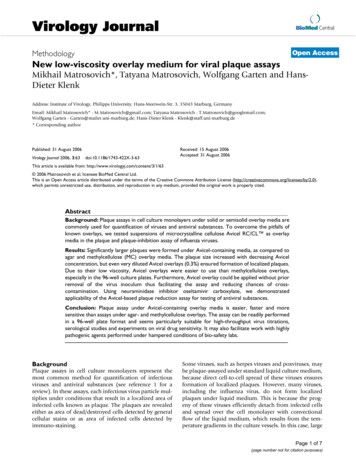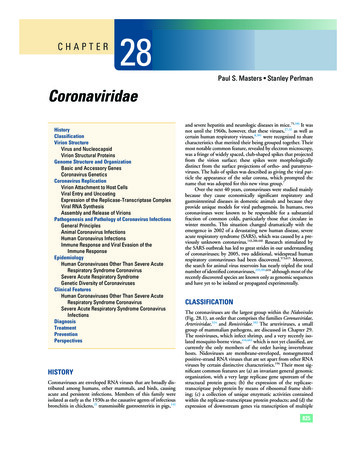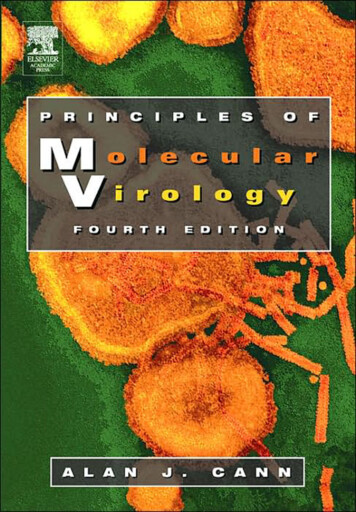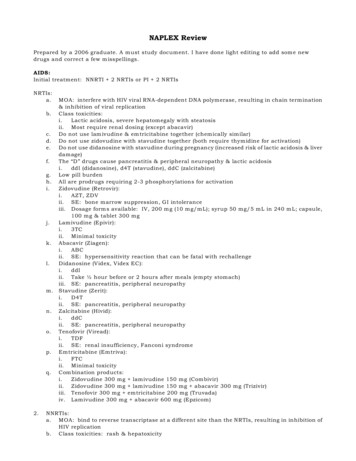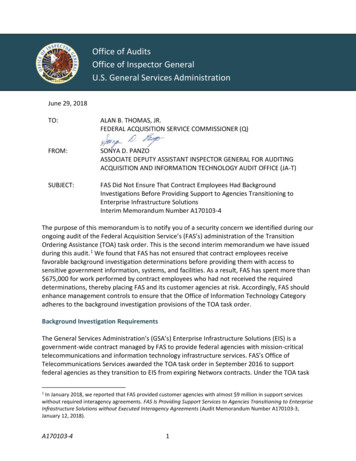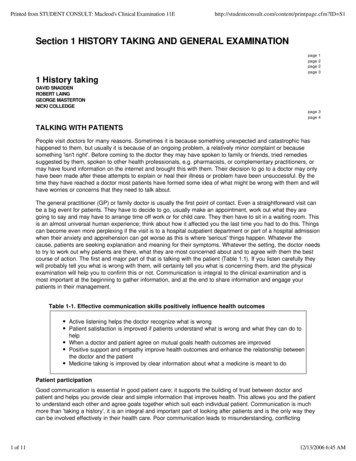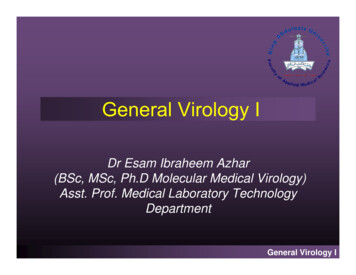
Transcription
General Virology IDr Esam Ibraheem Azhar(BSc, MSc, Ph.D Molecular Medical Virology)Asst. Prof. Medical Laboratory TechnologyDepartment١General Virology I
Lecture Outline Introduction History Definition of A virus Properties of unicellular microorganisms andviruses Viral structure Host range٢General Virology I
Introduction¾ Virology is the study of viruses, complexes ofnucleic acids and proteins that have the capacity forreplication in animal, plant and bacterial cells.¾ To replicate themselves, viruses use up functions ofthe host cells on which they are parasites.¾ The viral parasite causes changes in the cell,particularly its antigenicity; moreover, directing thehost cell's metabolism to the production of newvirus particles may cause cellular death.¾ Virally-induced cell death, changes in antigenicityand the response of the host to the presence of thevirus leads to the manifestations of viral disease.Viruses come in two basic types, those that have agenome of DNA and those that have a genome of RNA.٣General Virology I
1798Jenner“development of smallpox vaccine”٤General Virology I
17981890JennerIwanowski,Beijerinck,Loeffler &FroschInfectiveBacteria-FreeFiltrate٥General Virology I
17981890JennerIwanowski,Beijerinck,Loeffler &FroschLatin Word Meaning “Poison”٦General Virology I
179818901911JennerIwanowski,Beijerinck,Loeffler ion of Rous Sarcoma virus inChicken٧General Virology I
179818901911JennerIwanowski,Beijerinck,Loeffler &FroschRous Shope1933InfectiveBacteria-FreeFiltrate٨General Virology I
179818901911JennerIwanowski,Beijerinck,Loeffler &FroschRous Shope1933 1935StanleyTobacco Mosaic VirusComposed of NucleicAcid & Protein٩General Virology I
179818901911JennerIwanowski,Beijerinck,Loeffler &FroschRous Shope١٠1933 19351952Hershey,Stanley ChaseGeneral Virology I
179818901911JennerIwanowski,Beijerinck,Loeffler &FroschRous Shope1933 1935Stanley1976Fiers,Temin,EricksonRNA Tumor Virus١١General Virology I
179818901911JennerIwanowski,Beijerinck,Loeffler &FroschRous Shope1933 gnier19951984: Isolation of AIDS virus1995: Multiple drug treatment(protease inhibitors reverse transcriptaseinhibitors)١٢General Virology I
Definition of A Virus¾ Viruses are organized associations ofmacromolecules:nucleic acid (which carries the blueprint for thereplication of progeny virions) contained within aprotective shell of protein units.- On its own, a virus may be considered as an inertbiochemical complex since it cannot replicateoutside of a living cell. Once it has invaded a cell itis able to direct the host cell machinery tosynthesize new intact infectious virus particles(virions).- Because viruses are non-motile, they are entirelydependent on external physical factors for chancemovement and spread to infect other susceptiblecells.١٣General Virology I
Properties of Unicellular Microorganismsand rusdiameter(nm)1000500300250 25Type of nucleic acidDNA andRNADNA andRNADNA andRNADNA orRNABinary fission -Synthesis of proteins -Machinery of energyproduction --Growth out of cellularhosts --General Virology I
Relative Size of Viruses and Bacteria١٥General Virology I
Relative Size of DNA Viruses١٦General Virology I
Relative Size of Positive Strand RNA Viruses١٧General Virology I
Relative Size of Negative Strand RNA Viruses١٨General Virology I
green)١٩General Virology I
Virus Structure¾Viral components - generalViruses contain:a nucleic acid genome (RNA or DNA)a protective protein coat (called the capsid)The nucleic acid genome plus the protective proteincoat nucleocapsidThe nucleocapsid may have icosahedral or helicalsymmetryViruses may or may not have an envelope made of lipidderived from the host cell٢٠General Virology I
SUGARDNA1. Double Stranded2. Contains Deoxyribose3. Contains POCH2PHPCHNCHHONPHO2H HCH23OHHHCH2PCH2CH2HH٢١General Virology I
RNA1. Usually Single Stranded2. Contains Ribose3. Contains UridineOHHNCH2HOONH HHHOOH OH٢٢General Virology I
DNA VIRUS GENOMESSingle StrandedDouble StrandedRNA or -SegmentedDouble Stranded SegmentedCircular٢٣General Virology I
CAPSID FUNCTIONS Protection of Nucleic Acid Transport Nucleic Acid FromCell to Cell Provides Specificity forAttachment٢٤General Virology I
Viral Envelope¾ Enveloped viruses obtain their envelope by buddingthrough a host cell membrane. In some cases, thevirus buds through the plasma membrane but in othercases the envelope may be derived from othermembranes such as those of the Golgi body or thenucleus.¾ The envelope consists of a lipid bilayer and proteinsand always includes at least one virally coded proteininvolved in attachment.¾ Enveloped viruses do not necessarily have to kill cellin order to be released, since they can bud out of thecell - a process which is not necessarily lethal to thecell - hence some budding viruses can set uppersistent infections.٢٥General Virology I
ENVELOPED ROTEIN)NucleicAcidEnvelopetRNA(PROTEIN & LIPIDS)Ribosome٢٦EnzymesGeneral Virology I
Virion Nucleocapsid Structures (1)A) ICOSAHEDRALIcosahedron: solid figure, 20 faces, 5:3:2 rotationalsymmetry12 corners or vertices, 5-fold symmetry aroundverticesIcosahedralsymmetry in viruses٢٧General Virology I
Virion Nucleocapsid Structures (2)A) ICOSAHEDRAL (cont.)- The capsid shell is made of repeating subunits of viralprotein (may be one kind of subunit or several, accordingto the virus).- All faces of the icosahedron are identical.- The nucleic acid is packaged inside the capsid shell andprotected from the environment by the capsid.- Proteins associate into structural units (this is what onesees in the electron microscope or when start todisassociate a capsid), the structural units are known ascapsomers - capsomers may contain one or several kindsof polypeptide chain.- Capsids with icosahedral symmetry have 12 vertices,capsomers at the 12 corners have a 5-fold symmetry andinteract with 5 neighboring capsomers, and are thus knownas pentons (or pentamers).٢٨General Virology I
Adenovirus SymmetryHuman adenovirus seen by negativestainingLarger viruses contain more capsomers, extra capsomers arearranged in a regular array on the faces of the icosahedrons,these often have six neighbors and are called hexons (orhexamers).The size of such an icosahedron depends on the size andnumber of capsomers, there will always be 12 pentons, but thenumber of hexons may increase.٢٩General Virology I
Virion Nucleocapsid Structures (3)B) HELICALProtein subunits interact with each other and withthe nucleic acid to form a coiled, ribbon likestructure:e. g. tobacco mosaic virus, influenza virus, rabiesvirus.Helix may be very rod-like and inflexible (tobaccomosaic virus) or very flexible (Paramyxoviruses).٣٠General Virology I
Tobacco Mosaic Virus Structure Showing aHelical Capsid StructureTobacco Mosaic Virus٣١General Virology I
Virion Nucleocapsid Structures (4)C) COMPLEXRegular structures, but nature of symmetry notfully understood.Example: Poxviruses٣٢General Virology I
Complex Symmetry Found in PoxvirusesPox virus seen bynegative staining٣٣General Virology I
Basic Structural Forms Of Viruses InNature1. Naked icosahedral e.g. Poliovirus, Adenovirus,Hepatitis A virus2. Naked helical e.g. Tobacco mosaic virus, so farno human viruses with this structure known3. Enveloped icosahedral e.g. Herpes virus, Yellowfever virus, Rubella virus4. Enveloped helical e.g. Rabies virus, Influenzavirus, Parainfluenza virus, Mumps, Measles5. Complex e.g. Poxvirus٣٤General Virology I
٣٥General Virology I
Unconventional Agents¾There are also the 'unconventional agents'sometimes known as 'unconventional viruses'or 'atypical viruses' - the main kinds which havebeen studied so far are:1- VIROIDS2- PRIONS٣٦General Virology I
Viroids (1)¾Viroids contain RNA only. Small (less than 400nucleotides), single stranded, circular RNAs, theseare not packaged, do not appear to code for anyproteins, and so far have only been shown to beassociated with plant disease. However, there aresome suggestions that somewhat similar agentsmay possibly be involved in some human disease.٣٧General Virology I
Viroids (2)¾ So far the only known human disease agent to resembleviroids is hepatitis delta agent.- This agent has a small RNA genome, althoughsomewhat larger than the true viroids, but features ofthe nucleic acid sequence and structure are somewhatsimilar to viroids.- Hepatitis delta agent (also known as hepatitis deltavirus) does not code for its own attachment protein, butunlike the viroids, it is packaged - it acts as a parasiteon hepatitis B virus, and uses hepatitis B virusenvelopes with the hepatitis B attachment protein.- Hepatitis delta agent differs from viroids in that it doescode for a few proteins. In some ways hepatitis deltaagent appears to be intermediate between 'classicalviruses' and viroids.٣٨General Virology I
PrionsPrions contain protein only (although this issomewhat controversial). They are small,proteinaceous particles and there is controversyas to whether they contain any nucleic acid, butif there is any, there is very little, and almostcertainly not enough to code for protein:e.g. Scrapie, Kuru, Creutzfeldt-Jakobdisease, Gerstmann-Straussler syndrome٣٩General Virology I
Host Range¾ Viruses infect all major groups of organisms:vertebrates, invertebrates, plants, fungi, bacteria.¾ Some viruses have a broader host range than others,but none can cross the eukaryotic/prokaryotic boundary.Factors which affect host range include;i) whether the virus can get into the host cellii) if the virus can enter the cell, is the appropriatecellular machinery available for the virus toreplicate?iii) if the virus can replicate, can infectious virusget out of the cell and spread the infection?٤٠General Virology I
٣٨ General Virology I Viroids (2) ¾So far the only known human disease agent to resemble viroids is hepatitis delta agent. - This agent has a small RNA genome, although somewhat larger than the true viroids, but features of the nucleic acid sequence and structure are somewhat similar to viroids. - Hepatitis delta agent (also known as hepatitis delta virus) does not code for its own .

